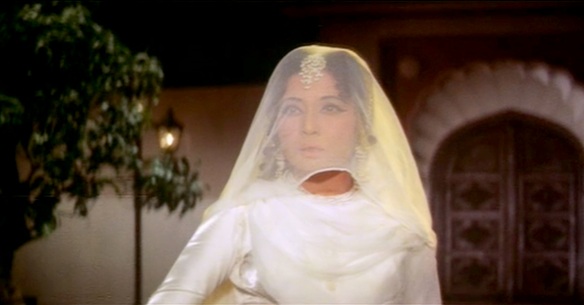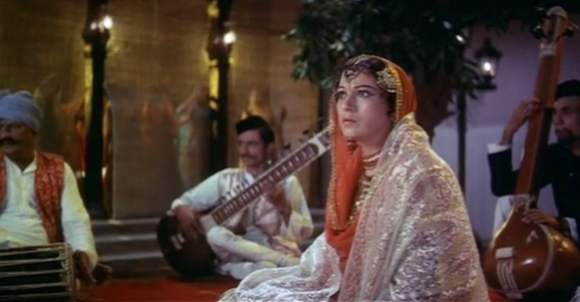
Dilip Kumar plays a swashbuckling raja who knows how to carry a tune in Kohinoor (1960).
Today we present the lyrics and English translation to the semi-classical “Madhuban Mein Radhika” from Kohinoor (1960). Dilip Kumar and Meena Kumari star in this masala film set during a romanticized period of Indian history when Hindu royalty were constantly engaged in sword-fights with their rivals, playing the sitar to the acclamation of their courtiers, and saving damsels in distress on horseback. Kohinoor is remembered today for the brilliant soundtrack and delightful script (read: you will not cringe and die during most of the comic scenes) as well a for the breezy performances by its hero and heroine. Meena Kumari giggles more in this film than in any of her other films combined!
Dilip Kumar as the young raja travels to the countryside and happens upon a musical assembly where a talented dancer, played by Kumkum, challenges anyone to perform a song to which she cannot dance. Naturally, our hero is ready with “Madhuban Mein Radhika” to the delight of the court while Kumkum gracefully dances kathak to his tune. Shakeel Badayuni’s straightforward Radha-Krishna poetry is the basis of a rollicking number that keeps everyone, especially Kumkum, on their toes. “Madhuban Mein Radhika” is a true gem among film songs, drawing heavily upon Hindustani classical traditions that are rare to find executed with such unabashed purism in Bollywood films. It comes as no surprise that the song has maestro Naushad written all over it. To fully appreciate all the ornaments of the piece, I think it’s high time we break for a little vocabulary lesson…
A Brief Hindustani Classical Music Vocabulary Lesson:
Tarana in Hindustani classical music were thought to be invented by the great poet Amir Khusro (1253-1325 CE). Legend has it that a music competition was held by the famous conqueror Alauddin Khilji in which Amir Khusro and Gopal Nayak, court musician to the King of Devagiri were the last men standing. Nayak performed raaga Kadambak in Sanskrit for six evenings straight while Khusro sat enthralled among the courtiers. On the seventh night, Khusro sang the same song, copying each note to perfection, but substituted Persian words and jargon for the lyrics as he did not understand Sanskrit. His amazing performance won him the competition and thus, the tarana was born. Persian couplets and notation for tabla are often intermingled into the tarana, however, the basic phonetics are Farsi-based (eg. yalali, odani, tadeem). The structure consists of a main melody that the performer repeats and elaborates on as well as a second, contrasting melody, that may include higher notes and is introduced once before returning to the main melody. The taranas featured in Lata Mangeshkar’s “Tare Rahiyo” from Pakeezah (1972) and the Pakeezah (1972) Title Music are some of the film’s highlights.
Sargam is the vocalization of the notes that define the raga in which the song is sung. Improvisation ascending and descending the scale allows the audience to understand the raagas range and boundaries, often occurring at the beginning or the end of the piece. The sargam typically incorporates improvisation upon themes to set the tone of the piece. A great example of a beautiful mid-song sargam is in Asha Bhonsle’s “Nigahen Milane Ko” from Dil Hi To Hai (1960).
Alaap is similar to sargam, but does not name the notes, using instead simply the aakaar (“aah” sound) to create music. It frequently opens a piece, but can be interjected in the middle, or at the end for dramatic effect–as well as intermingled among the sargam with artistic license. One of my favorite alaaps from films is Suman Kalyanpur’s heavenly interjection above Hemant Kumar midway through “Na Tum Humen Jano” from Baat Ek Raat Ki (1963). In “Madhuban Mein Radhika,” listen for Mohammed Rafi’s silky alaap to start off the song and entrance his audience.
Taan, is similar to an alaap, but is much more fast-paced and showcases the singer’s vocal abilities. The two taans in this song (picturized on comedic actor Mukri) were sung by Ustad Niyaz Ahmed Khan. Bollywood film songs Kal Nahii.N Paaye Jiya from Chhoti Si Mulaqat (1967) and Tu Hai Mera Prem Devta from Kalpana (1960) feature multiple beautiful taans punctuating each stanza.
Jugalbandi is a playful competition between two performers in which one mimics the other, and then surpasses. A challenging test of both the ability to perfectly imitate and then improvise, a jugalbandi between two master musicians is absolutely thrilling to witness. This is commonly between two instrumental performers, but as in “Madhuban Mein Radikha,” is briefly showcased as between the singer and the tabla player (note: the lyrics actually reference the Carnatic mridangam, which is a different percussion instrument than the Hindustani tabla, however, a tabla is indeed is picturized in the film). Another fun example of jugalbandi in Bollywood is at the ending of the song Muqabala Humse Na Karo from Prince (1969).

Kumkum entrances her audience with a kathak performance based on classic Radha-Krishna imagery in Kohinoor (1960).
Are we all on the same page now? Because I’m fully expecting you to count the taal as you check out the music video here. Follow along with our English translation of the lyrics to “Madhuban Mein Radhika” from Kohinoor (1960) below! How many lovely ornaments of Hindustani classical music can you hear in the song?
Madhuban Mein Radhika Nache Lyrics and Translation:
ALAAP: Aaaah aaaah aaaah
madhuban mei.N radhikaa nache re
In the honey gardens, Radha danced
Girdhar kii muraliiya baje re
As the flute of Krishna played
pag mei.N ghuunghar baandhke
With dancing bells tied to her leg
ghuunghaT mukh par daal ke
With a veil placed upon her face
nainan mei.N kajraa lagaake re
With kajal applied to her eyes
madhuban mei.N radhikaa nache re
In the honey gardens, Radha danced
Dolat chham-chham kaminii
The beautiful lady swayed and sparkled
Chhamakat jaise daamini
Her sparkle was like lightening
Chhanchal, pyarii chhab laage re
Her face appeared mischievous and lovable
madhuban mei.N radhikaa nache re
In the honey gardens, Radha danced
mridang baje…
The drum was played…
Tirikitadhum Tirikitadhum Ta Ta
mridang baje
Tirikitadhum Tirikitadhum
Naachath Chum Chum
ThaThay ThaThay Thatha
Chum Chum ChanaNaNa
Chum Chum ChanaNaNa
Dhan Dhakdan Dhakdan Dha
Dha Dha Dha
madhuban mei.N radhikaa nache re…
TAAN: Aaaaaaaah
madhuban mei.N radhikaa…
TAAN: Aaaaaaaah
madhuban mei.N radhikaa nache re
madhuban mei.N radhikaa…
SARGAM :
Ni Sa Re Sa Ga Re Ma Ga Pa Ma
Dha Pa Ni Dha SA Ni RE SA
RE SA Ni Dha Pa Ma Pa
Dha Ni SA RE SA Ni Dha Pa Ma Pa
Ga Ma Pa Ma Ga Ma Re Sa
madhuban mei.N radhikaa nache re…
SA SA SA Ni Dha Pa
Ma Pa Dha Pa Ga Ma Re Sa Ni Re Sa
Sa Sa Ga Ma Dha Dha Ni Dha SA
madhuban mei.N radhikaa nache re
madhuban mei.N radhikaa…
TARAANAA:
Ode NaDir DiTa NiTa DhaRe Dhim, Dhim Ta Na Na
Nadir DiTa NiTa DhaRe Dhim, Dhim Ta Na Na
Nadir DiTa NiTa DhaRe Dhim, Dhim Ta Na Na
JUGALBANDI:
NaDir DiTa NiTa DhaRe
(tabla response)
ODe Tana Dhir Dhir Tana
Dhir Dhir Dhir Dhir
Thum Dhir Dhir Dhir
(tabla response)
Dha Tirikita Tak , Thum Tirikita Tak
Tirikita Titikita Ta DhaNi
NaDir DiTa NiTa
ODe NaDir DiTa niTa
ODe Nadir Dita NiTa
DhaRe Dhim Dhim Ta Na Na ….
Glossary:
madhuban: sweet garden, honey garden; Radhikaa: Radha, gopi lover of Krishna; nachnaa: to dance; girdhar: Lord Krishna; muralii: flute; baajnaa: to play; pag: leg; ghuungar: dancing bells; baandhnaa: to bind, to tie; ghuungaT: veil; mukh: face: Daalnaa: to place, to put; nainan: eyes; kajraa: eyeliner; Dolat: sway; chham-chham: sparkling; kaamini: beautiful lady; daamini: lightening; chhanchal: mischievous; pyaarii: loveable; chhab: face; mridangam: traditional Carnatic percussion instrument

Dilip Kumar jams his sitar with rockstar attitude in Kohinoor (1960).
Dilip Kumar’s performance in Kohinoor (1960) garnered the Filmfare award for Best Actor that year. According to Naushad, Dilip Kumar the perfectionist, supposedly learned how to play the sitar just for this song. While that may seem extreme, anyone who has seen Raj Kapoor fail miserably to pretend play the piano (as much as we love the man) will appreciate how big a difference this makes in any self-respecting musical number.
Wondering what’s up with the snake and the mongoose at the end of the song? Naturally, every self-respecting raja-rani film needs at least one assassination-by-cobra attempt…amiright?
– Mrs. 55














